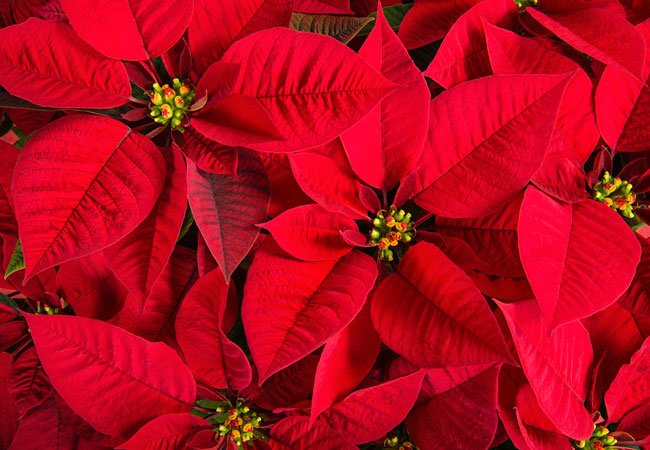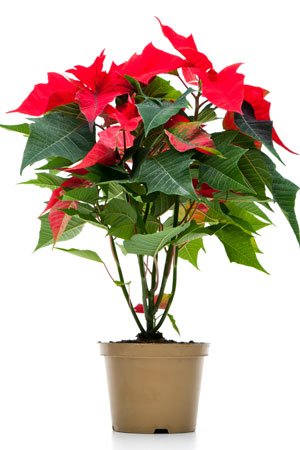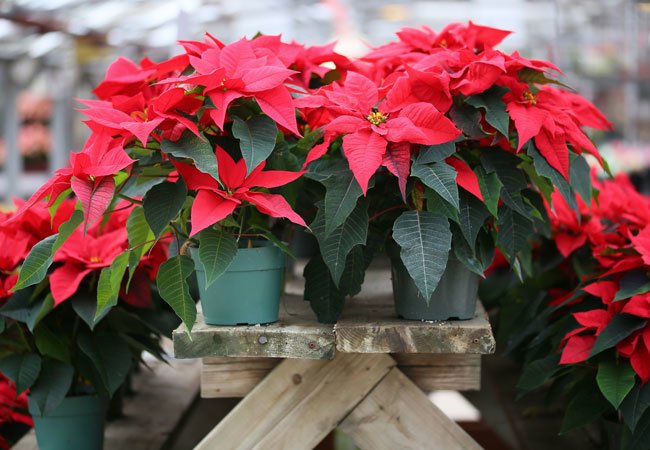

We may earn revenue from the products available on this page and participate in affiliate programs. Learn More ›
During the holidays, nothing rivals the floral festivity of the season’s favorite plant: the always colorful poinsettia (Euphorbia pulcherrima). Whether you prefer the traditional red variety or favor hybridized pastel pinks and yellows, you’ll want to provide the best poinsettia care in order to enjoy the plant’s showstopping blooms as long as possible. Simply abide by these six best practices—and avoid the six biggest mistakes—when tending to this ornamental houseplant.
DO Purchase the Healthiest Plant You Can Find
When shopping for a poinsettia, choose a stocky plant with dense foliage that’s deep green in color, and pass on plants with yellowing or dropped leaves. The colorful flowers, called bracts, should be firm with little or no pollen visible in the center.
DON’T Forget to Protect the Plant in the Car
Some stores sell poinsettias in cellophane cones that will protect the plant from wind damage, but if it’s bitterly cold outside, the bracts and leaves could still suffer. Ask for a larger bag to put over the top of your plant to protect it on the trip to the car and into your home.
DO Position Your Poinsettia in a Well-Lit Location
A southern window is ideal. Poinsettias benefit from plenty of direct daytime light to keep them from getting leggy. If a sunny window isn’t available, choose as bright a spot as possible.
DON’T Let the Leaves Touch a Freezing Windowpane
Poinsettias are tropical plants typically grown in greenhouses, so despite their popularity in winter, they despise the cold. Any leaves that press against an icy window after you position the plant in your home will perish, and the chill could even affect the health of the poinsettia as a whole. Prevent an untimely demise by setting your poinsettia safely on a table in front of a window rather than on a windowsill.
DO Make Sure Your Plant Gets Adequate Darkness
In order for those red or white flowers to last more than a month, poinsettias require more than 12 hours of darkness during their peak bloom period. If you’ve placed the plant in a room that you keep lit all evening, just move it to a darker room, closet, or shadowy corner when the sun sets, then put it back in the window the next morning.

DON’T Put Your Poinsettia in a Drafty Spot
The tender leaves and bracts wilt in windy conditions, so keep your plant away from open windows, forced-air registers, and fans.
DO Water Your Plant
Poinsettias should be watered whenever the soil surface feels dry to the touch. The best way to water the plant is to move it, pot and all, to the sink and soak it thoroughly. Let it drain until no more water runs out—this will take about an hour—and then place it back in its spot.
DON’T Let Your Poinsettia Stand in Water
Sure, soaking your poinsettia’s soil is the best way to quench its thirst, but be sure to pull off the shiny foil wrapper that came tucked around the pot before you water it. Though pretty, this wrapping prevents the water from draining out, leaving the poinsettia’s soil saturated and roots soggy. Waterlogged roots stress the plant and can lead to leaf-dropping—or worse, a short life.
DO Prune Your Poinsettia If You Plan to Reflower It Next Year
Follow the poinsettia care tips outlined so far, and you may find that your houseplant survives from winter into spring—or even longer. If you plan on keeping it around, prune the stems back to six inches when the plant begins to get leggy, and continue to place it in a sunny spot that’s about 65 degrees Fahrenheit. Continue to water just as you did before, and feed your poinsettia regularly every two weeks after they’ve stopped blooming with a standard houseplant fertilizer (view example on Amazon). New shoots will eventually develop at the buds below the cuts. In late spring, when overnight temps outdoors are above 50 degrees, prune new shoots back to four inches and sink your poinsettia—pot and all—into a protected spot in your flower bed and let it stay there until early fall when overnight temps dip back into the 40s. While year-round poinsettia care takes commitment on your part, you’ll be rewarded with an even-larger floral wonder the following holiday season.
DON’T Leave a Large Poinsettia in a Tiny Pot
As a poinsettia grows over the summer, its roots grow as well, and they can get cramped in a small pot. So, when you bring your poinsettia indoors after its spring and summer sojourn in the flower bed, be sure to transfer it into a larger planter. Repotting keeps the plant from becoming root-bound. Choose a new pot about two inches wider and an inch or two deeper than your current pot to give your poinsettia’s roots room to spread out during the coming fall growing season and help stimulate foliage growth and bloom production.
DO Keep Pets Away from Poinsettia
One thing pretty much everyone knows about poinsettia care is the importance of keeping poinsettias out of the reach of furry members of the family. While scare stories link the plants to pet poisoning, the milky sap of the poinsettia actually contains low-toxicity chemicals that can cause vomiting, diarrhea, drooling, and itchiness if a pet eats a large amount. Even though the risk is pretty low, don’t chance it. Keep your plant away from Fluffy or Fido.
DON’T Hesitate to Call Your Vet If Your Animal Eats It (Just in Case)
The pesticides used at garden centers and nurseries could cause reactions if your pet ingests poinsettia leaves, especially if you have a very young animal. If you’re concerned about persistent or severe symptoms, call your vet or the ASPCA Animal Poison Control Center at 888-426-4435. A consultation fee may apply.

